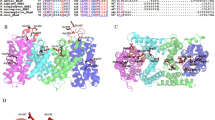Abstract
Resistance to selenate and chromate, toxic analogues of sulphate, was used to isolate a mutant of Saccharomyces cerevisiae deficient in the capacity to transport sulphate into the cells. A clone which complements this mutation was isolated from a cDNA library prepared from S. cerevisiae poly(A)+ RNA. This clone contains an insert which is 2775 by in length and has a single open reading frame that encodes a 859 amino acid polypeptide with a molecular mass of 96 kDa. Sequence motifs within the deduced amino acid sequence of this cDNA (SUL1) show homology with conserved areas of sulphate transport proteins from other organisms. Sequence analysis predicts the position of 12 putative membrane spanning domains in SUL1. When the cDNA for SUL1 was expressed in S. cerevisiae, a high affinity sulphate uptake activity (Km = 7.5 ± 0.6 μM for SO 2−4 ) was observed. A genomic mutant of S. cerevisiae in which 1096 by were deleted from the SUL1 coding region was constructed. This mutant was unable to grow on media containing less than 5 mM sulphate unless complemented with a plasmid containing the SUL1 cDNA. We conclude that the SUL1 cDNA encodes a S. cerevisiae high affinity sulphate transporter that is responsible for the transfer of sulphate across the plasma membrane from the external medium.
Similar content being viewed by others
References
Bissig M, Hagenbuch B, Steiger B, Koller T, Meier PJ (1994) Functional expression cloning of the canalicular sulfate transport system of rat hepatocytes. J Biol Chem 269: 3017–3021
Breton A, Surdin-Kerjan Y (1977) Sulfate uptake in Saccharomyces cerevisiae: biochemical and genetic study. J Bacteriol 132: 224–232
Clarkson DT, Hawkesford MJ (1993) Molecular approaches to plant nutrition. Plant Soil 155/156: 21–31
Clarkson DT, Hawkesford MJ, Davidian J-C (1993) Membrane and long distance transport of sulfate. In: De Kok LJ (ed) Sulfur nutrition and assimilation in higher plants: regulatory agricultural and environmental aspects. Second workshop on sulfur metabolism in higher plants, Garmisch-Partenkirchen, Germany, 21–25 April, 1992. SPB Academic Publishing, The Hague, Netherlands, pp 3–19
Gaber RF (1992) Molecular genetics of yeast ion transport. Int Rev Cytol 137A: 299–353
Geitz D, St. Jean A, Woods RA, Schiestl RH (1992) Improved method for high efficiency transformation of intact yeast cells. Nucleic Acids Res 20: 1425
Hoffman CS, Winston F (1987) A ten-minute DNA preparation from yeast efficiently releases autonomous plasmids for transformation of Escherichia coli. Gene 57: 267–272
Jones DT, Taylor WR, Thornton JM (1994) A model recognition approach to the prediction of all-helical membrane protein structure and topology. Biochemistry 33: 3038–3049
Ketter IS, Marzluf GA (1988) Molecular cloning and analysis of the regulation of cys-14 +, a structural gene of the sulfur regulatory circuit of Neurospora crassa. Mol Cell Biol 8: 1504–1508
Ketter JS, Jarai G, Fu YH, Marzluf GA (1991) Nucleotide sequence, messenger RNA stability, and DNA recognition elements of cys-14, the structural gene for sulfate permease II in Neurospora crassa. Biochemistry 30: 1780–1787
Kouchi H, Hata S (1993) Isolation and characterization of novel nodulin cDNAs representing genes expressed at early stages of soybean nodule development. Mol Gen Genet 238: 106–119
Lawrence CW (1991) Classical mutagenesis techniques. Methods Enzymol 194: 273–281
Marzluf GA (1994) Genetics and molecular genetics of sulfur assimilation in the fungi. Adv Genet 31: 187–206
Nissen P (1991) Multiphasic uptake mechanisms in plants. Int Rev Cytol 126: 89–134
Rose MD, Winston F, Heiter P (1990) Methods in yeast genetics; a laboratory course manual. Cold Spring Harbor Laboratory Press, Cold Spring Harbor, New York
Sandal NN, Marcker KA (1994) Similarities between a soybean nodulin, Neurospora crassa sulphate permease H and a putative human tumour suppressor. Trends Biochem Sci 19: 19
Schmutz D, Brunold C (1982) Rapid and simple measurement of ATP-sulfurylase activity in crude plant extracts using an ATP meter for bioluminescence determination. Anal Biochem 121: 151–155
Schweinfest CW, Henderson KW, Suster S, Kondoh N, Papas TS (1993) Identification of a colon mucosa gene that is down-regulated in colon adenomas and adenocarcinomas. Proc Natl Acad Sci USA 90: 4166–4170
Sherman F (1991) Getting started with yeast. Methods Enzymol 194: 3–21
Smith FW, Hawkesford MJ, Prosser IM, Clarkson DT (1993) Approaches to cloning genes encoding for nutrient transporters in plants. Plant Soil 155/156: 139–142
Author information
Authors and Affiliations
Additional information
Communicated by C. P. Hollenberg
Rights and permissions
About this article
Cite this article
Smith, F.W., Hawkesford, M.J., Prosser, I.M. et al. Isolation of a cDNA from Saccharomyces cerevisiae that encodes a high affinity sulphate transporter at the plasma membrane. Molec. Gen. Genet. 247, 709–715 (1995). https://doi.org/10.1007/BF00290402
Received:
Accepted:
Issue Date:
DOI: https://doi.org/10.1007/BF00290402




